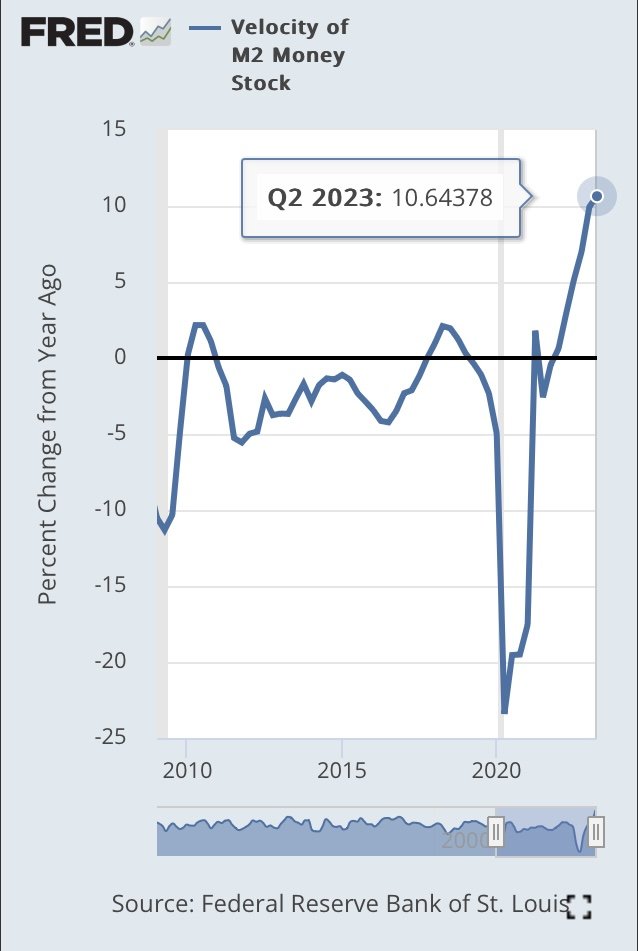And The Money Never Stopped Moving…Fed Reports Biggest Rise in History of the Velocity of M2 Money Supply
/By Stan Szymanski
The Federal Reserve has just reported the largest year over year rise in history of the velocity of the M2 money supply with a 10.6% increase from one year ago.
Photo credit: (FRED)
The Velocity of Money is defined by the Federal Reserve as:
…’the number of times one dollar is spent to buy goods and services per unit of time. If the velocity of money is increasing, then more transactions are occurring between individuals in an economy.’… (FRED 7/27/23)
The M2 Money Supply …’is the U.S. Federal Reserve's estimate of the total money supply including all of the cash people have on hand plus all of the money deposited in checking accounts, savings accounts, and other short-term saving vehicles such as certificates of deposit (CDs). Retirement account balances and time deposits above $100,000 are omitted from M2.’… (Investopedia)
What are the potential implications of a record increase in the velocity of the M2 money supply? How about some serious inflation for starters?
___________________________
Please refer to our proviso at the end of the article regarding any reproduction of this writing and consider a donation to Encouraging Angels today.
—————————————-
Martin Armstrong of Armstrong Economics told us that the real inflation for the year 2022 for the average person was 32%. He more recently reported that while inflation came down a little that it still hovered at roughly 26%.
Now we receive this report from the Fed of the record velocity of the M2 money supply. The velocity of money is usually measured as a ratio of gross domestic product (GDP) to a country's M1 or M2 money supply. The word velocity is used here to reference the speed at which money changes hands. A high velocity of money is typically associated with a healthy and expanding economy. An increase in the use of and availability of electronic banking can also contribute to an increase in velocity.
But what if the situation is different than a traditional ‘good’ economy? What if now the government of that country had to outlay more money to buy its own bonds to finance the country because more and more nations are jettisoning the US dollar in a repudiation of US Treasury bonds? The other body politic around the world used to finance the operation of the US through the purchase of our debt. That is now all but gone.
What if the average person realized that inflation is now persistent and that it is better to spend your money than to leave in in the bank to be ravaged by the inflation documented by Mr. Armstrong?
What if the average person is starting to understand that taking their money out of the bank and out of the financial system and putting it into something tangible is the better choice? What if people now understand that having a store of food is utterly important (and spent more of their money every month to acquire it)? What if they have begun to look into (and spend the money on) alternative energy systems like solar power to make sure that they can at least run some of their household electricity needs in a brownout or a blackout? What if they realized that the filtering, purifying and storing of water (and the necessary purchases of said filters etc.) was a better use of the money they had sitting in the bank?
These things lead to a higher exchange of or a higher velocity of money. This current velocity is not normal, nor is it good. It was not good in the Weimar Republic when people stopped hoarding their savings as they did during the war (WWI) and found it wiser to put it into anything tangible so their nest egg didn’t completely vaporize. To understand what this really means, please consider reading ‘When Money Dies’ by Alan Fergusson:
…’The gold value of the money in circulation, equivalent to nearly £300 million before the war, and to £83 million in July 1922, had by November fallen to £20 million. The more notes were printed, the lower the value fell — illustrating the Copernican thesis expounded by King Sigismund of Poland in 1526 that 'money loses its value when it has become too much multiplied.' How the business of the country could be carried on with so small an amount of real currency mystified many observers, and accounted for the ever-mounting pressures on the bank to go on printing. That trade continued notwithstanding was usually explained by reference to the accelerating velocity with which money circulated. Notes were held for as short a time as possible. Private-account cheques were hardly accepted. Anyone receiving money for goods quickly converted it back into other goods, and the money never stopped moving, doing the work of ten times the amount moving a tenth as fast.’… (When Money Dies by Alan Fergusson, page 77 pdf).
…’and the money never stopped moving’…
It is quite easy to deduce that a dollar left in the bank is losing purchasing power quickly. Inflation for 2022 was 32% as noted above. A market basket of canned food bought at the beginning of 2022 and held to the end of 2022 would have roughly kept pace with inflation (+32%). If you had to buy that same food with the dollars in your bank account you could only buy 2/3 as much food at the end of 2022 as you could have at the beginning of 2022. I believe that people are now realizing this and the money is starting to move faster (higher velocity) to reflect this new fact of life.
When the average person ultimately realizes that holding precious metals is the only true means of preserving wealth as money that is outside of the ultimately crumbling and simultaneously all-controlling system (Central Bank Digital Currency), the velocity of money will reach its undeniable zenith.
What is also undeniable is that the world we knew is now changing at a velocity faster than that of the money supply.
———-
If you appreciate this article can you consider a gift to Encouraging Angels for the intelligence we provided today? Click this link to give. We need the support. Links to this article are encouraged. Reproductions of this writing are only allowed by written permission of the author and those reproductions must include this proviso of request for support, how this writing may be reproduced and following disclaimers.
All rights reserved.
Stan Szymanski (or Encouraging Angels) is not a medical doctor. This is not medical advice. In all matters pertaining to the health and care of a human being consult a medical doctor. This is not legal, financial or personal advice. Consult appropriate professionals in those fields for that type of advice.

